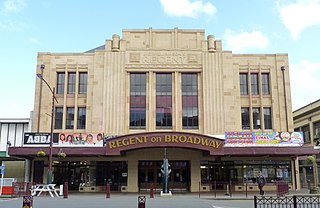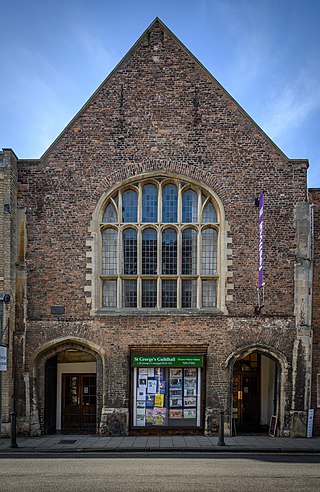
Oamaru is the largest town in North Otago, in the South Island of New Zealand, it is the main town in the Waitaki District. It is 80 kilometres (50 mi) south of Timaru and 120 kilometres (75 mi) north of Dunedin on the Pacific coast; State Highway 1 and the railway Main South Line connect it to both cities. With a population of 14,350, Oamaru is the 28th largest urban area in New Zealand, and the third largest in Otago behind Dunedin and Queenstown. The town is the seat of Waitaki District, which includes the surrounding towns of Kurow, Weston, Palmerston, and Hampden, which combined have a total population of 23,200.

The Royal Ballet and Opera, formerly the Royal Opera House (ROH), is a major performing arts organisation, based at the historic Royal Opera House in Covent Garden, central London. The large building is often referred to as simply Covent Garden, after a previous use of the site. The Royal Ballet and Opera is the parent company of The Royal Opera, The Royal Ballet, and the Orchestra of the Royal Opera House, all based at the Royal Opera House. The first theatre on the site, the Theatre Royal (1732), served primarily as a playhouse for the first hundred years of its history. In 1734, the first ballet was presented. A year later, the first season of operas, by George Frideric Handel, began. Many of his operas and oratorios were specifically written for Covent Garden and had their premieres there.

Geraldine is a town in the Canterbury region in the South Island of New Zealand. It is about 140 km south of Christchurch, and inland from Timaru, which is 38 km to the south. Geraldine is located on State Highway 79 between the Orari and Hae Hae Te Moana Rivers and 45 kilometres to the east of Fairlie.

Kurow is a small town in the Waitaki District, New Zealand. It is located on the south bank of the Waitaki River, 60 kilometres (37 mi) northwest of Oamaru. The name is an Anglicised form of the Māori name of the nearby mountain, Te Kohurau.

Rangiora is the largest town and seat of the Waimakariri District, in Canterbury, New Zealand. It is 29 kilometres (18 mi) north of Christchurch, and is part of the Christchurch metropolitan area. With an estimated population of 19,400, Rangiora is the 30th largest urban area in New Zealand, and the fifth-largest in the Canterbury region.

Queen Street is the major commercial thoroughfare in the Auckland CBD, Auckland, New Zealand's largest city. The northern end is at Queens Wharf on the Auckland waterfront, adjacent to the Britomart Transport Centre and the Downtown Ferry Terminal. The road is close to straight, the southern end being almost three kilometres away in a south-southwesterly direction on the Karangahape Road ridge, close to the residential suburbs in the interior of the Auckland isthmus.

The Christchurch Town Hall, since 2007 formally known as the Christchurch Town Hall of the Performing Arts, opened in 1972, is Christchurch, New Zealand's premier performing arts centre. It is located in the central city on the banks of the Avon River overlooking Victoria Square, opposite the former location of the demolished Christchurch Convention Centre. Due to significant damage sustained during the February 2011 Christchurch earthquake, it was closed until 2019. Council staff initially recommended demolition of all but the main auditorium, but at a meeting in November 2012, councillors voted to rebuild the entire hall. In 2020, the town hall was registered as a Category I heritage building.

The Royal Whanganui Opera House is a theatre located in Whanganui, New Zealand. Built in 1899, it is New Zealand's last Victorian theatre. Located on St Hill Street in central Whanganui, the theatre seats 830 and is a venue for many local, national and international events.

Tameside Hippodrome is a 1262 seat theatre located in Ashton-under-Lyne, Greater Manchester, England.
Architecture of New Zealand is the built environment of regions, cities and towns of New Zealand.

The Auckland Town Hall is an Edwardian building on Queen Street in the Auckland CBD, New Zealand, known both for its original and ongoing use for administrative functions, as well as its famed Great Hall and separate Concert Chamber. Auckland Town Hall and its surrounding context is highly protected as a 'Category A' heritage site in the Auckland District Plan, registered by Heritage New Zealand as a Category I Historic Place.
Waitaki Boys' High School is a secondary school for boys located in the northern part of the town of Oamaru, Otago, New Zealand, with day and boarding facilities, and was founded in 1883. As of 2020, it has a school roll of approximately 400 students.

The Regent on Broadway is a large theatre in Palmerston North, New Zealand, named so because it is the Regent Theatre on Broadway Avenue.

The Dunedin Town Hall, also known as the Dunedin Centre, is a municipal building in the city of Dunedin in New Zealand. It is located in the heart of the city extending from The Octagon, the central plaza, to Moray Place through a whole city block. It is the seat of the Dunedin City Council, providing its formal meeting chamber, as well as a large auditorium and a conference centre. The oldest part of the building has been called the only substantial Victorian town hall still in existence in New Zealand.

The Waitaki District Council building, the former Oamaru Chief Post Office, is the seat of the Waitaki District in Oamaru, New Zealand.

Stratford City Hall is the city hall of Stratford, Ontario, and a National Historic Site of Canada. It sits amidst the city's business district, on a triangular town square.

The Civic Theatre is a theatrical venue in the southern New Zealand city of Invercargill.

The Guildhall of St George is a Grade I listed building in King's Lynn, Norfolk, England. The Guild of St George was founded in 1376 and constructed the Guildhall between 1410 and 1420. It is the largest extant guildhall in England. It has been in use as a theatre since 1445, making it the oldest theatre still operating in the United Kingdom, and the only one still in existence in which William Shakespeare is believed to have performed. The building is in the ownership of the National Trust, which has leased it to King's Lynn and West Norfolk borough council for hire as a music, performances, lectures and entertainment venue.

The Clock Tower Chambers, also known as the Westport Municipal Chambers, are the former municipal offices in Westport, New Zealand. Built during World War II, the building has been described as "possibly the jewel in the crown of West Coast historic buildings". It has a Category I registration with Heritage New Zealand.

New Zealand performing arts venues are places in New Zealand that are set up to host performing arts and music events such as theatre, dance and concerts.



















